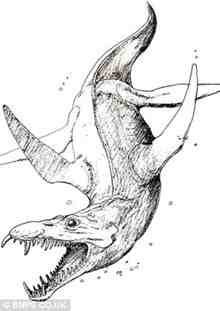Scientists are using one of Britain's most powerful CT scanners to probe inside the fossilised skull of the biggest sea monster that ever lived.
 The X-rays will help build a life-size 3D picture of the pliosaur predator, which was four times more powerful than a Tyrannosaurus Rex.
The X-rays will help build a life-size 3D picture of the pliosaur predator, which was four times more powerful than a Tyrannosaurus Rex.
The enormous skull of the colossal beast was painstakingly unearthed piece by piece over an eight year period along Britain's Jurassic Coast by fossiler Kevin Sheehan.
Experts pieced it together and established it was a pliosaur - an aquatic reptile - that was 60ft long, weighed 12 tonnes and terrorised the oceans 150 million years ago.
Scientists believe the pliosaur is the top predator of all time and could 'have had a T Rex for breakfast'.
More than twice the size of a killer whale, its 8ft long jaw was 4.5 times more powerful than a T-Rex and would easily swallow a human whole or bite a car in two if around today.
With razor sharp teeth, it was capable of devouring any creature that shared the tropical shallow seas that is now Dorset, such as a dolphin-like ichthyosaurs The skull remains were found following years of erosion along the cliffs near Charmouth in Dorset.
 Experts unveiled the remarkable discovery last year and are now using the powerful CT scanner at the University of Southampton to penetrate deep inside the dense fossil.
Experts unveiled the remarkable discovery last year and are now using the powerful CT scanner at the University of Southampton to penetrate deep inside the dense fossil.
It is hoped the scans will establish the giant is a species that is new to science.
The scanner will take thousands of X-rays to build up an image of inside the fossilised skull.
 Dr Mark Mavrogordato, an engineer at the University of Southampton, said: 'We have to extract the most information from the fossil and we certainly don't want to destroy it so this really is the perfect tool.
Dr Mark Mavrogordato, an engineer at the University of Southampton, said: 'We have to extract the most information from the fossil and we certainly don't want to destroy it so this really is the perfect tool.
'In the end, we will have a 3D volume representing the original specimen.
'You can slice it, dice it, however you want, as if you could dissect it with a knife, but you are doing it digitally and non-destructively.'
The team has begun scanning the fossil one piece at a time to reveal as complete a pliosaur picture as possible, including information about the internal bone structure and the positioning of hidden teeth.
The fossil, which comprises a lower jaw and upper skull, is currently being removed from its rocky casing by palaeontologist Scott Moore-Fay.
The work will take more than 1,000 hours to complete and once each piece had been cleaned up it is sent to the University of Southampton for scanning.
Palaeontologist Richard Forrest said: 'We hope that these CT scans will show the internal structure of the jaws, and how they were built to withstand such incredible forces.
'By understanding this, we can learn more about its behaviour - how it hunted and attacked other creatures.' The scans will also help to confirm whether this species is new to science.
 Mr Forrest said: 'From the outside, it looks similar to other pliosaurs found in the UK, although much much bigger.
Mr Forrest said: 'From the outside, it looks similar to other pliosaurs found in the UK, although much much bigger.
'By looking at the inner architecture of the skull, in particular the brain-case, we should be able to establish if this is a species that we have not seen before.'
Pliosaurs were a form of plesiosaur, a group of giant aquatic reptiles that dominated the seas around the same time that dinosaurs roamed the earth.
They had short necks and four paddle-like limbs to propel their bulky bodies through the water.
They probably would have 'thrashed other animals around and torn chunks off', much like a crocodile does today with much smaller pray.
Mr Sheehan, 64, from Osmington, near Weymouth, was paid about 10,000 pounds by Dorset County Council for his monumental find.
Dr Richard Edmonds, the earth science manager for the Jurassic Coast, said: 'It was the top predator of the seas at the time and arguably the top predator of all time.
'It is the most impressive animal you could ever imagine.
'This part of the coastline is eroding really rapidly and that means the fossils that are trapped and buried are constantly tumbling out on to the beach.
'Mr Sheehan was lucky enough to come along on the day a large piece fell out of the cliff, and that gave him the clue to keep on looking.
'That was about nine years ago and he went back day after day, and as a result he uncovered this absolutely incredible fossil.
'The skull is in about 25 different pieces with the biggest weighing 130lbs, so God knows how he managed to get that off the beach.'
Source: Daily Mail [December 23, 2010]





